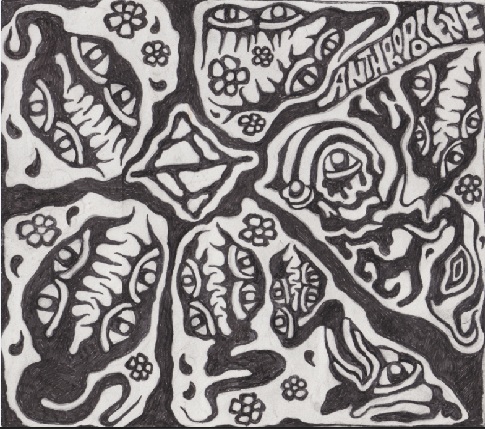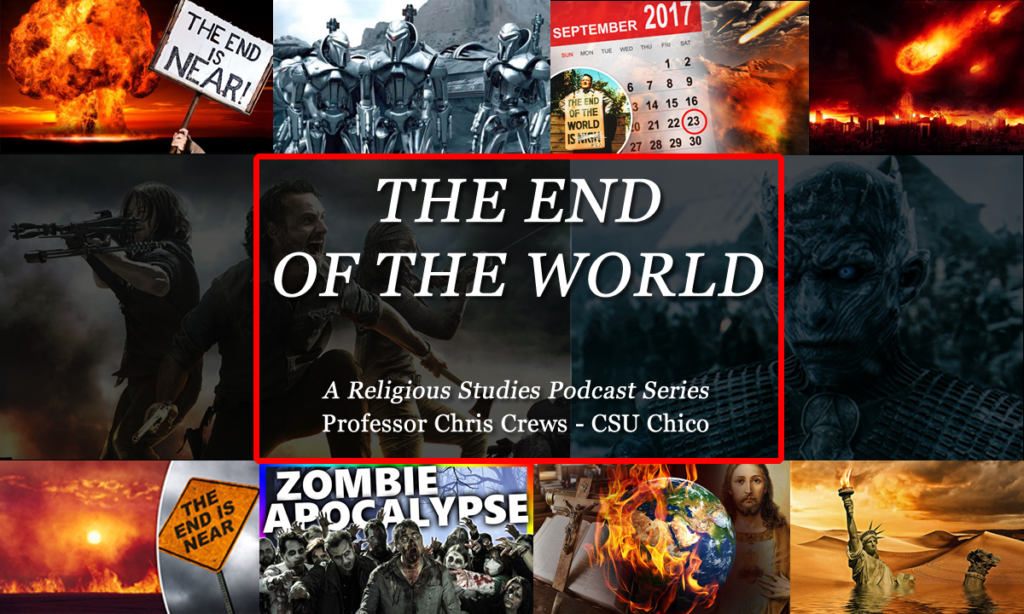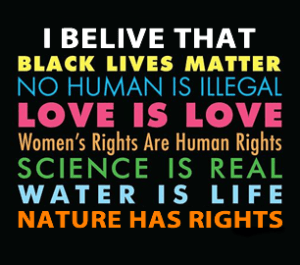Theorizing the Anthropocene – part 1
The following thoughts are part of a longer response I have been writing in response to comments on my PhD dissertation proposal on the Anthropocene, Monsters in the Greenhouse, which you can find here. This is the first of several posts working through some of the idea initially developed in that proposal.
I understand that there is a certain amount of ambiguity in how I am using the Anthropocene, and I think this is partly a reflection of the wide use of the term in the literature I have been reviewing. While the original concept of the Anthropocene is housed in the geosciences, the majority of instances where the Anthropocene emerges is my review so far has been in relation to environmental discourses and human impacts on the planet. Two of the clearest examples of this can be seen in an article from the Geological Society of America’s Today magazine titled “Is the Anthropocene an issue of stratigraphy or pop culture?,” and a post by Andrew Revkin on his NY Times Dot Earth blog titled “The ‘Anthropocene’ as Environmental Meme and/or Geological Epoch.” In both of these post the authors question the scientific merits of the term as a stratigraphic demarcation while suggesting there may be more merit in the more generic environmental idea. The GSA article argues the Anthropocene “may become iconic in pop culture [but this fact] is not in itself sufficient evidence to amend formal stratigraphic practice” (GSA Today 22:7), while Revkin argues that the “world is not waiting for the geologists to decide, of course. Run a Web search for the Anthropocene and 520,000 results pop up…It is a phenomenon” (NYT 9/17/12).
In addition, I have come across the Anthropocene in everything from West Coast punk rock zines and right wing political journals to Midwest death metal albums (see above) and random personal blogs. In other words, the idea is everywhere, with the basic idea being that the Anthropocene—call it a meme, a concept, an idea, a frame, or a proposal—is catching on and is understood as having something to do with humans causing lots of major, and mostly negative, impacts to the planet. Therefore I see one important component of this project being to provide a conceptual mapping of this emerging discursive landscape—a who, what, when, where and how investigation if you will—of this term and where it is appearing, and to link this to my argument about how the Anthropocene is becoming a dominant way to think about and frame contemporary environmental issues and challenges, from global warming and ocean acidification to species extinction and overpopulation.
In this sense I am less interested in a detailed analysis of the Anthropocene as a historical concept than I am in the evolution of this idea within public discourse. So I think I am approaching the Anthropocene more along the lines of an assemblage of practices as alluded to in comments and less as a historical idea. Although the scientific community is split between those who want to formalize the Anthropocene and those who are skeptical that there is enough evidence to warrant a new stratigraphic time designation (epoch or era), this is ultimately less important to my thinking.
First, much of the above debate seems to be a disciplinary turf battle over who gets to decide what constitutes legitimate “stratigraphic evidence” for a new epoch or era, and gets into debates over what would be the ideal “basal Anthropocene” and how to establish a golden spike with enough global evidence to warrant a new planet-wide classification under existing stratigraphic codes. While perhaps important from a strict stratigraphic science perspective—which seems to be one driving motivation, especially clear in the GSA Today article—it is of marginal importance to the public and larger environmental debates about human impacts to the Earth.
Secondly, I am in no position to judge the scientific merits of various stratigraphic proposals, and whatever the various international geologic societies (ICS, etc) ultimately decide will determine the final fate of this term. But this debate has marginal bearing on the public understanding and use of this term. Even if the Anthropocene is adopted as a formal epoch, and a golden spike is finally settled on, it will not have any real bearing on the larger environmental politics which I am interested in, and which many other scientific using the Anthropocene are also writing about.
However I do believe the history of the geologic science which made it possible for this idea to emerge when it did is relevant to larger environmental questions, as it gets to the heart of how we understand things like “deep-time” and historic climate variability, questions which continue to be a point of conflict with young earth creationists and other Biblical fundamentalists organizing against climate change and environmental politics generally. Thus this aspect of the geoscience history does have a direct bearing on contemporary environmental politics. That is why I believe the initial focus on tracing the historical emergence of this idea is important, as it will help to foreground the later discussion and case studies of contemporary fundamentalist arguments which fractured at the moment when the natural sciences emerged from under the theological hegemony of natural philosophy. So the history of earth history is an important first component of this project, but when I move from this historical genealogy to the introduction of the Anthropocene as an environmental concept I plan to switch gears from historical survey to intentional political analysis focused on popular culture and the environment.
The move I am trying to make here is two-fold. First, I want to show how the emergence of the Anthropocene is an attempt to provide some larger conceptual framework to the environmental changes happening on a planetary scale. No suitable holistic framing concept really existed previously, even within the environmental community, where terms like climate change or global warming or deforestation or biodiversity loss were meant to signal some larger set of processes. Perhaps the closest concept prior to this term entering the discourse was the idea of a tipping point or of ecological collapse, but neither had the zing or the breadth of the Anthropocene. Since 2000 some additional concepts have been created to complement the holistic intent of the Anthropocene—the most relevant example being the idea of Planetary Boundaries, which many advocates of the Anthropocene have been involved in developing, but even here the term is more about measuring impacts and less about the deeper philosophical import. This point about environmental holism is important for several reasons.
So why not talk about ecological risk or bio-politics or geoecology instead of the Anthropocene? First, much of the ecological risk and biopolitics literature is framed in terms of human values—physical infrastructure, economic losses, security preparedness, etc. While not the only framing, it is certainly the dominant one from what I have come across in the literature. What is important and distinct about the Anthropocene is that it is primarily focused on shifting the focus from the human to the underlying ecosystem—ocean acidification, melting arctic icecaps, biodiversity loss, nitrogen and phosphorus cycling, etc. This framing can more easily move away from the problematic anthropocentrism within much environmental security literature and towards a more ecocentric (and perhaps also posthuman) understanding of politics.
This is important as one of the central points of contention that I see framing current environmental debates is between a human-centric environmentalism and an ecosystem-centered environmentalism, or to put it somewhat simplistically, between deep ecology (eco) and shallow ecology (anthropo). By focusing on the Anthropocene over these other possible frames for considering environmental risk what I am trying to do is focus attention on how the collapsing ecological foundation of the planet is itself the preeminent risk, rather than isolated and individual human impacts to the planet—logging in this forest, loss of coral reefs off that coast, contaminated water in this river, etc. The Anthropocene offers a way to view these risks as part of a larger systemic problem that no other environmental framing seems able to do, including the comprehensive work of the UN Millenium Ecosystem Assessment.
Secondly, part of the argument I intend to make is that the idea of the Anthropocene reflects the context of contemporary environmental debates taking place within highly industrialized capitalist nations about post-natural, post-environmental and end of nature politics. Although these debates cannot easily be summarized here—that is the aim of the chapter on the Anthropocene as new environmental frame, one of the central points of disagreement driving these debates is the status of “nature” in the future of environmental politics. The first group, represented by the shallow ecology/bright green enviro movement, wants to blur the line between humans and nature while reaffirming human domination and the logic of “natural resource management” and “ecosystem services.” The second group, represented by the deep ecology/dark green enviro movement, also wants to blur the line between humans and nature but fundamentally rejects human domination and the logic of management. These two views have at their core a fundamentally different ecological ontology—ecocentric versus anthropocentric—and it is this debate which I believe is now playing out in how these environmental debates are being linked to the idea of the Anthropocene. The struggle between these radically different environmental worldviews is the defining element of modern environmental politics, a split which has polarized the general public and the environmental community alike.
For example, the increasingly blurry lines being drawn between humans and nature or nature and culture can be seen in the rise of posthuman and deep ecological politics (cf. Bill McKibben’s on the end of nature, Danna Haraway’s idea of the naturalcultural and the cyborg, Jacques Derrida’s L’animal que donc je suis, Bruno Latour’s work on actants and fetishes, Jane Bennett’s vibrant materialism and David Abram’s new animism, to name just a few examples). Most of these authors either reject or problematize the old Cartesian dualisms as well as advocate for rethinking our ecological relations. Here the Anthropocene complements these new modes of thinking, as the concept shows how human interventions have reached such a scale of magnitude that we are now experiencing the results of our actions in the context of natural feedback cycles and processes—climate change, rising sea levels, erratic weather, droughts, floods, etc. It is becoming increasingly difficult to separate “natural” risks from “human” created risks, which is essentially the same claim underlying the Anthropocene.
The importance of this debate becomes clear when we examine environmental risk from these two different environmental positions. The shallow ecology view is that more capitalism, more technology and more development will solve our current environmental problems and that there are no inherent limits which cannot be overcome through innovation and investment. The real risk is in not pushing forward in these areas and leaving more people in poverty as the world develops. The deep ecology view of risk is that it is precisely this industrial capitalist development logic that is producing new risks, all of which will continue to grow more deadly with time. The most clear sign of this is the continued denial of any real ecological limits—CO2 tipping points, overpopulation, peak oil, industrial collapse—combined with total political inaction at the international level. One need only look at the failures of Kyoto and now the Rio+20 as evidence of this. Here again the focus is understood either in terms of risk to people (anthropo) or risk to the environment (eco), another reason why the environmental framing of risk within the Anthropocene becomes critical.
To be continued in part 2…
###



